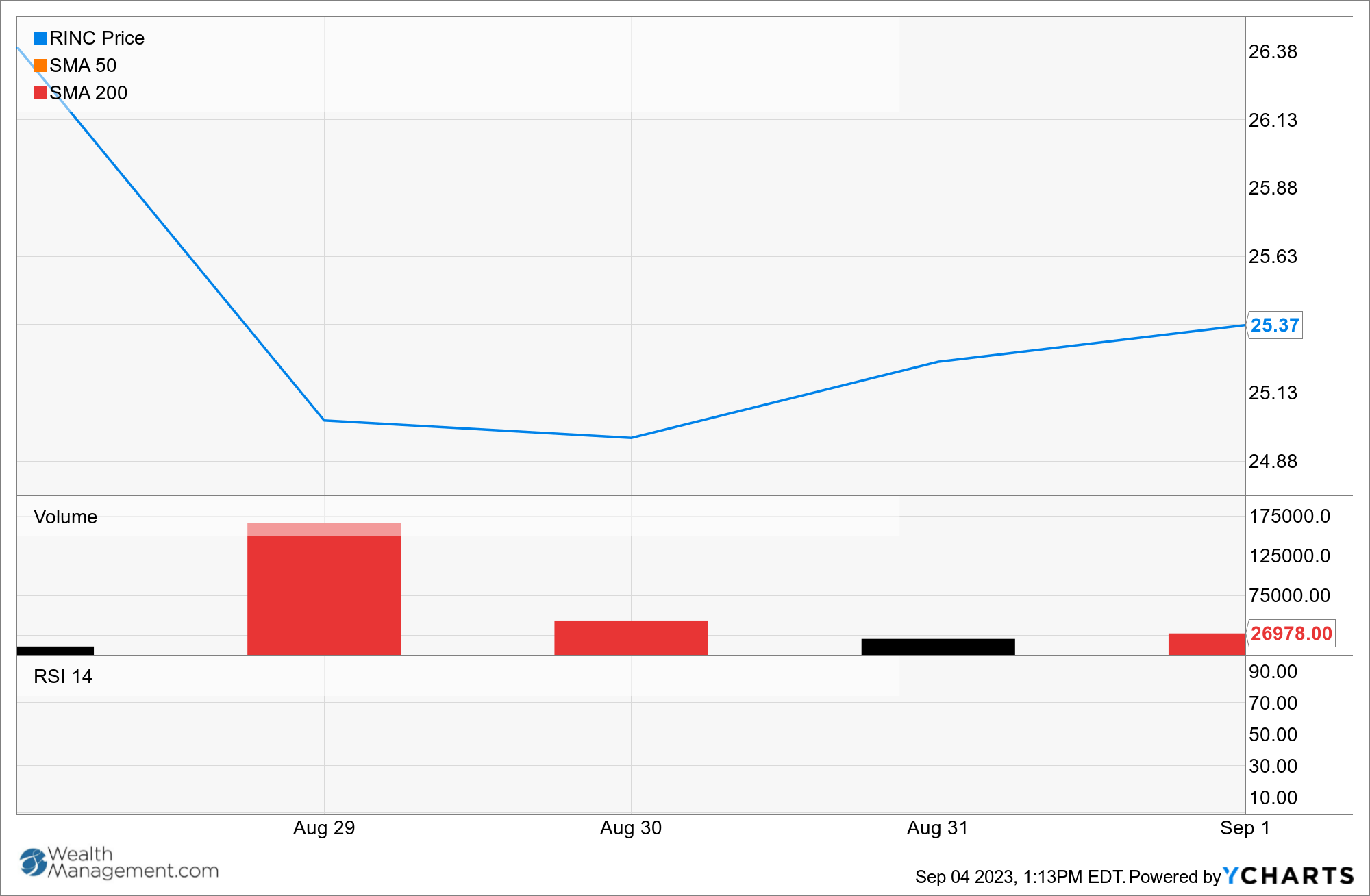AXS Investments, an asset manager providing access to alternative investments, last week announced the launch of AXS Real Estate Income ETF (RINC). RINC seeks to track the performance of a real estate debt index created by Gapstow Capital Partners
a New York City-based management consulting firm that specializes in advising senior leaders of alternative credit investment management firms
It joins a small group of similarly-themed ETFs including the VanEck Mortgage REIT Income ETF (MORT) and iShares Mortgage Real Estate ETF (REM), which also based on indexes composed of U.S. REITs that hold U.S. residential and commercial mortgages. A key difference with those ETFs is that RINC is equally weighted by sector—50% commercial real estate lending, 25% non-agency residential real estate debt, and 25% agency residential real estate debt—with mortgage REITs within those sectors also equally weighted. The index rebalances quarterly to maintain this diversified exposure.
WMRE spoke with Chris Acito, CEO of Gapstow, to discuss the new ETF launch and why there are opportunities now to invest in real estate debt.
This interview has been edited for style, length and clarity.
WMRE: Can you talk about the Gapstow Real Estate Income index that you created and that the ETF is tracking?
Chris Acito: When Gapstow began thinking about this, it was, ‘How do you begin tracking the mortgage REIT market?’ which we found pretty interesting. Our interest overall is in alternative credit. There are some indices out there already. But we thought there was a better way to approach it. There are a few other mortgage REIT products, but it’s pretty thin from a product development standpoint, unlike equity REITs, where there are dozens of funds.
We are using it to explore the residential and commercial real estate world. The goal was to create a really good income product. It doesn’t supplant high yield bonds, but it acts as a good complement. … If you are building a diversified yield portfolio, you would want to take exposure to residential and commercial real estate debt to complement the traditional exposure to corporate debt.
WMRE: The ETF has a set breakdown between in how its allocating to debt. Can you talk about that approach?
Chris Acito: The goal was to create a balance between commercial and residential. Within residential we wanted to take equal exposure to agency and non-agency debt. At the highest level, if commercial and residential dance to their own drummers, you would want some diversification. We did not want to do a market cap weighted index. By cap weighting, you don’t come up with the same breakdown of commercial/residential. We thought it would be appealing to tell people every quarter that we rebalance to 50/50.
WMRE: And for your purposes, do you count multifamily debt as residential or commercial?
Chris Acito: Multifamily is in the commercial real estate allocation. To put it more technically correct, the commercial real estate REITs are the ones that hold multifamily debt, by and large.
The definitions of the REITs are ours. We go in and classify mortgage REITs in one of these three categories. If they walk and talk like a commercial real estate REIT, we use objective measures to determine that and put them om the commercial real estate lending sector.
WMRE: How did you come to work with AXS on this product?
Chris Acito: A mutual friend realized our mutual interest in wanting a well-designed, unique way of getting at income and getting at things that are in the debt space. A friend that knew us well said to talk to AXS. AXS wanted to put together a similar product and it began there. In some ways it was quite simple in that regard. This was a little before rates were going up and so the desire to have income was that much greater. I think it’s still a desirable thing to want to have in the portfolio and one of the reasons we prioritized that and accessed it as a product idea.
WMRE: This is launching at an interesting time within the real estate market. Rates are rising. There’s lots of uncertainty. And, of course, there’s lots of talk about distress.
Chris Acito: The product development began with the bigger picture in mind. “How do you create a yield intensive product that could fulfill a long term strategical role in asset allocation policy?” Some discussions when we were having them back a year and half ago, the idea that we would be timing market entry for the second half of 2023 was not something we had predetermined. That said, now that we are here, it is an interesting time to be looking at mortgage REITs.
Mortgage REITs are trading at significant discounts. The valuation is reasonably attractive. Rates going up means that new loans are going to be made at ever higher interest rates. On the CRE side, those REITs are going to be primary beneficiaries of banks pulling back from lending for the next few years. On the residential side, credit quality is very strong and as we learned in March with the regional bank failures that bond math is tough when rates take a steep raise up and especially when yield curves invert. But that was then, this is now. Spreads in mortgage-backed securities are also very attractive.
If you believe that interest rates are going to normalize over the next year or two, the bond math works both ways. A normal yield curve combined with mortgage rates stabilizing is beneficial. I can’t say that we planned the timing, but it is an interesting time for mortgage REITs.
WMRE: How are you presenting this to financing advisors and investors?
Chris Acito: Part of partnership is Gapstow working with AXS in telling ppl about role of real estate debt within a portfolio and the rollout strategy for sure will be partly proselytizing about those pluses and minuses and beginning to educate people on this. While there may be a small segment of the investing population that is familiar with mortgage REITs, I think it’s a pretty small group. Our goal is to educate and make investors more generally knowledgeable of the segments that are out there. We’ll be talking podcasts, research papers and getting people familiar with the asset class overall.
WMRE: There’s a lot of talk now as well about the role of the traditional 60/40 portfolio and the potential role of private investments and alternative investments. Do you have a take on that, granting that there’s no one-size-fits-all approach?
Chris Acito: Yes, it’s different for every investor. If the traditional is 60% equity and 40% investment-grade fixed income, I think the big move is that people are beginning to rethink that 40%. And I think if you take pension plans, as an example, there is no question they have been substituting alternative credit assets for traditional fixed income. And real estate debt is certainly a component of that. So, I think what we are going to see is just as high yield corporate bonds have begun to work their way into that 40%, you will see other forms of alternative credit. It won’t just be mortgage REITs, but also private BDCs, driven by individual investor segments. I think the vehicles and funds that provide access to alternative credit will continue to grow in popularity in the next few years.
WMRE: There’s also a lot of broad doom-and-gloom about commercial real estate. I think that’s probably driven by overestimating how much the problems in the office sector can be generalized to the overall market. But that sentiment is out there, so how do you deal with questions from investors?
Chris Acito: We have gotten some questions about, “Isn’t this the worst time to be investing?” and that’s driven by the headlines about office. Coming back to the original design of the index, this is why we want balance between residential and commercial. Residential credit quality is looking awfully good. On the commercial real estate side, first of all office is a minority of that. The best we can estimate is that of commercial mortgage REITs that are part of this index, office is about 20% of the overall portfolio. And then this gets back to basic education as well, there is a difference between debt and equity and while neither lender nor owner wants to see a building go into bankruptcy, debt investors have equity underneath them to protect at least a bit.
But again, to take our index, which we want to be reflective of the market, commercial real estate is 50% of the index. Office is 20% of the 50%. So, we are down to 10% of the index. And only a portion of that debt is in distress and only a portion of that might see some impairment. I don’t mean to speak lightly of that. Mortgage REITs, like banks, are levered balance sheets. Impairments get levered by the leverage. So, they do leave a mark when they happen, but for all the people passing judgement, leading commercial mortgage REITs are trading at reasonable discounts to book value. Not all. But most still are.






